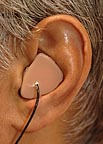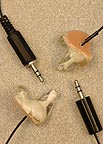July 13, 2007
Researcher's work may aid profoundly disabled

Caption follows story
Lalit Gupta, professor of electrical and computer engineering in the SIUC College of Engineering, is a leader in harnessing signals generated by the human body and using them to control mechanical devices.
The human body and brain constantly emit electrical impulses or other signals relative to whatever it is doing, hearing or seeing at any given time, Gupta said. Researchers can observe these events through a variety of methods, including placing electrodes on a subject's head and recording the electrical activity.
The problem for researchers is tuning out the extraneous "noise" and identifying the specific signals they are looking for.
Gupta's work focuses on signal pattern recognition, or discerning the specific voluntary control signals generated by the body or by the brain in response to external audio (tones) or video (pictures) stimuli. Once he detects these patterns he can devise ways for the subject to control a device such as a computer or wheelchair by using those specific signals as controlling signals.
Recently, a company called Think-a-Move began marketing a wheelchair based on technology Gupta helped perfect. The wheelchair is controlled by the changes in air pressure inside a subject's Eustachian tube that occur when the person moves his/her tongue to different places inside their mouths.
Think-a-Move engineers had suspected that the tongue movements caused changes in the pressure but needed a researcher to develop a strategy to correlate the changes in the air pressure with different tongue movements. The company approached Gupta in 2003.
Gupta developed a strategy to filter the signals and to automatically detect, segment and classify the ear pressure signals associated with moving one's tongue to the left, right, up or down. SIUC students served as test subjects as Gupta distilled the specific air pressure signatures associated with the tongue movements.
The system uses a small, hearing aide-like device that is actually a microphone. Once placed in the ear canal, it can detect the subtle air pressure changes associated with certain tongue movements and send them via a wire to a control unit hooked to the wheelchair.
"We were able to verify this approach works and got to where we could recognize these signals 97 percent of the time," Gupta said. The signals are largely the same for everyone, but the machine can be fine tuned to the individual using it.
A person can control the wheelchair by moving their tongue to different positions. Where a person is capable of more complex tongue movements, such as flicking the tongue up twice, the system can achieve up to 20 different commands. International media and scientific magazines are reporting on the technological breakthrough.
Gupta also sees other potential applications for such devices and technology, such as devising communication methods for disabled persons who are fully aware but unable to communicate.
"It would help in very simple, binary, conversations," Gupta said. "A person would be able to answer yes or no, or communicate other ideas. There wouldn't be a large market for this, but for the people who need it, it would be very valuable."
The U.S. Army also is interested in a related technology as a means of hands-free control for vehicles. Gupta's research has shown a similar ear device inside the Eustachian tube can detect and discern spoken words. Because the device is inside the ear canal, it is shielded from the high ambient noise of the battlefield or heavy vehicle and therefore easier to use for voice command devices.

Caption follows story
Caption:
New wheelchair controller – Lalit Gupta, professor of electrical and computer engineering Southern Illinois University Carbondale, demonstrates a device that measures the changes in air pressure in the Eustachian tube caused by moving one’s tongue. A company called Think-a-Move recently began marketing a wheelchair based on the technology, which Gupta helped perfect at SIUC. The technology allows a disabled person to control the wheelchair by moving their tongue to different positions inside their mouth.
Photo by Russell Bailey
